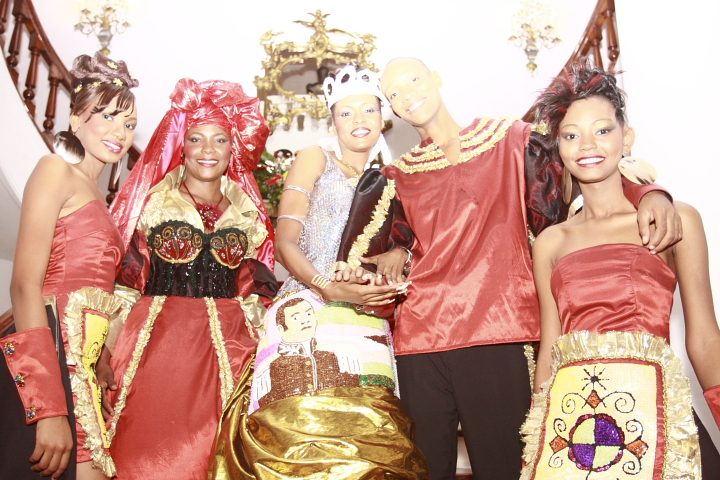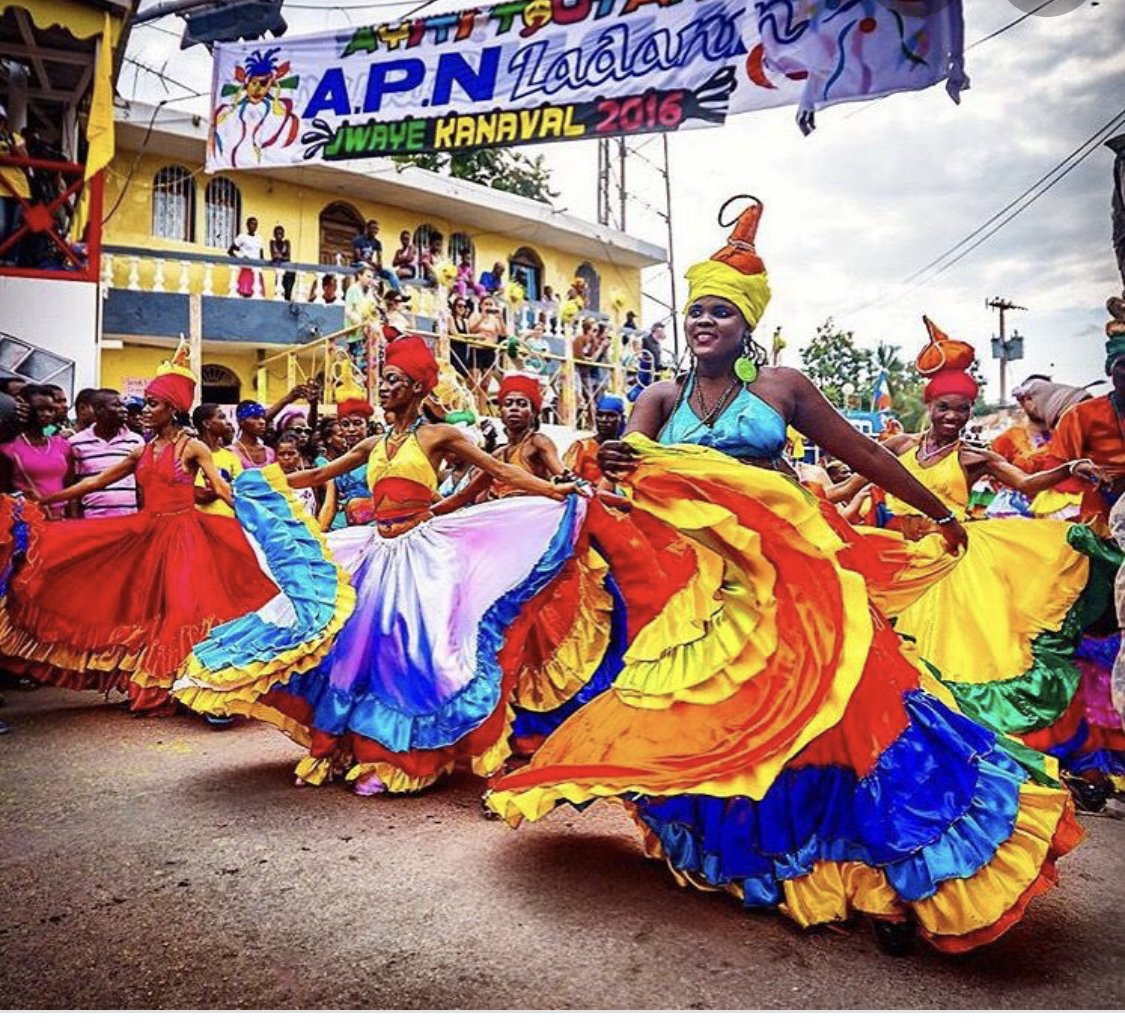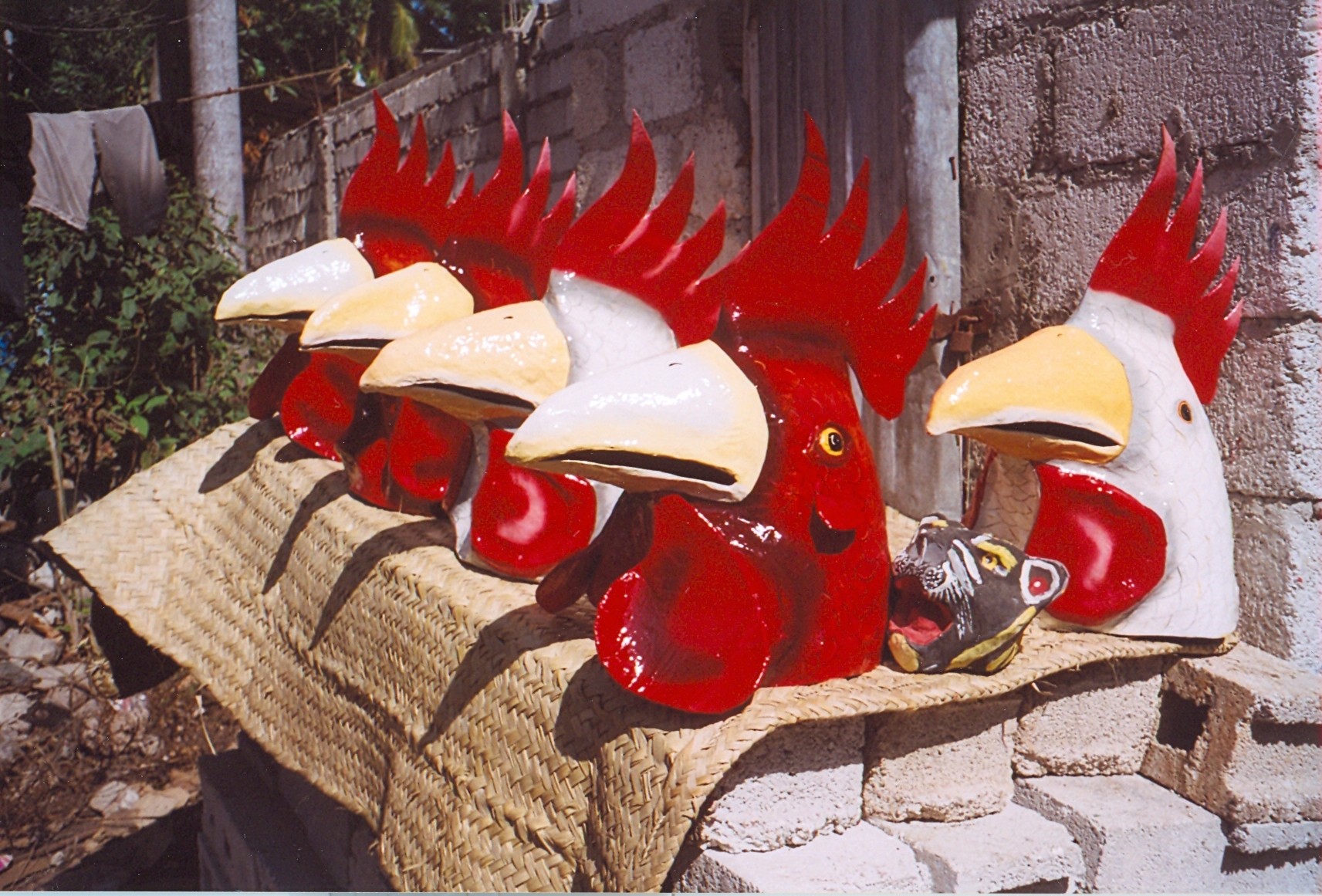Haitian Carnival on:
[Wikipedia]
[Google]
[Amazon]
Haitian Carnival ( ht, Kanaval, french: link=no, Carnaval) is a celebration held over several weeks each year leading up to Mardi Gras. ''Haitian Defile Kanaval'' is the
 Port-au-Prince's annual carnival is one of the largest Mardi Gras carnivals in the Caribbean and North America. The celebrations are funded by the government, businesses and wealthy Haitian families. Haiti's version of carnival season always starts in January, known as ''Pre-Kanaval'', and the main carnival begins in February each year. Carnival celebrations end on Mardi Gras, which is French for ''Fat Tuesday'', also known as Shrove Tuesday. Mardi Gras is the Tuesday before the Roman Catholic holiday known as
Port-au-Prince's annual carnival is one of the largest Mardi Gras carnivals in the Caribbean and North America. The celebrations are funded by the government, businesses and wealthy Haitian families. Haiti's version of carnival season always starts in January, known as ''Pre-Kanaval'', and the main carnival begins in February each year. Carnival celebrations end on Mardi Gras, which is French for ''Fat Tuesday'', also known as Shrove Tuesday. Mardi Gras is the Tuesday before the Roman Catholic holiday known as  The carnival is celebrated with music, bands and parades. Parades have floats, sometimes with children participating in the celebrations. The floats typically have sound systems set up on trucks to play music to the crowds. Food stands selling barbecued treats and rum are a popular part of celebrations. There are also comedy plays put on by the carnival participants, often satirizing political topics. Revelers wear masks and costumes, as they do at other carnival celebrations in the Caribbean, North America, and Central and South America. The parades makes their way through the streets of Port-au-Prince and end with celebrations at the large plaza, Champ de Mars, located across from the Palais national (National Palace), the former residence of Haiti's president.
Music is central to Haiti's carnival. Musicians perform zouk, rap kreyòl rap, ''konpa'' ( Compas), and ''mizik rasin''. The carnival is the largest annual event where bands can gain more public exposure and it provides the opportunity to perform at large concerts. Popular kompa bands participate in the carnival, such as T-Vice, Djakout No. 1, Sweet Micky also known as Michel Martelly,
The carnival is celebrated with music, bands and parades. Parades have floats, sometimes with children participating in the celebrations. The floats typically have sound systems set up on trucks to play music to the crowds. Food stands selling barbecued treats and rum are a popular part of celebrations. There are also comedy plays put on by the carnival participants, often satirizing political topics. Revelers wear masks and costumes, as they do at other carnival celebrations in the Caribbean, North America, and Central and South America. The parades makes their way through the streets of Port-au-Prince and end with celebrations at the large plaza, Champ de Mars, located across from the Palais national (National Palace), the former residence of Haiti's president.
Music is central to Haiti's carnival. Musicians perform zouk, rap kreyòl rap, ''konpa'' ( Compas), and ''mizik rasin''. The carnival is the largest annual event where bands can gain more public exposure and it provides the opportunity to perform at large concerts. Popular kompa bands participate in the carnival, such as T-Vice, Djakout No. 1, Sweet Micky also known as Michel Martelly,
 The large official public celebration of carnival in Haiti started in 1804 in the capital of Haiti,
The large official public celebration of carnival in Haiti started in 1804 in the capital of Haiti,
{{Carnival around the world Carnivals in Haiti Haitian culture Haitian Vodou Music festivals in Haiti Parades in Haiti Folk festivals in Haiti Events in Port-au-Prince
Haitian Creole
Haitian Creole (; ht, kreyòl ayisyen, links=no, ; french: créole haïtien, links=no, ), commonly referred to as simply ''Creole'', or ''Kreyòl'' in the Creole language, is a French-based creole language spoken by 10–12million people wor ...
name of the main annual Mardi Gras carnival held in Port-au-Prince
Port-au-Prince ( , ; ht, Pòtoprens ) is the capital and most populous city of Haiti. The city's population was estimated at 987,311 in 2015 with the metropolitan area estimated at a population of 2,618,894. The metropolitan area is define ...
, Haiti
Haiti (; ht, Ayiti ; French: ), officially the Republic of Haiti (); ) and formerly known as Hayti, is a country located on the island of Hispaniola in the Greater Antilles archipelago of the Caribbean Sea, east of Cuba and Jamaica, and s ...
.
The parade is known as "Kye Marn". Haiti's largest carnival is held in the capital and largest city, Port-au-Prince, with smaller celebrations taking part simultaneously in Jacmel, Aux Cayes, and other locations in Haiti. The annual carnival celebrations coincide with other Mardi Gras carnivals around the world.
Haiti also has smaller carnival celebrations
Celebration or Celebrations may refer to:
Film, television and theatre
* ''Celebration'' (musical), by Harvey Schmidt and Tom Jones, 1969
* ''Celebration'' (play), by Harold Pinter, 2000
* ''Celebration'' (TV series), a Canadian music TV serie ...
during the year that are separate from the main carnival. These include Rara, a series of processions taking place during the Catholic
The Catholic Church, also known as the Roman Catholic Church, is the largest Christian church, with 1.3 billion baptized Catholics worldwide . It is among the world's oldest and largest international institutions, and has played a ...
Lent
Lent ( la, Quadragesima, 'Fortieth') is a solemn religious moveable feast#Lent, observance in the liturgical calendar commemorating the 40 days Jesus spent fasting in the desert and enduring Temptation of Jesus, temptation by Satan, according ...
season, that has bands and parades like the larger main carnival, and also an annual ''Carnaval des Fleurs'', that takes place on 7 July.
Carnival
Ash Wednesday
Ash Wednesday is a holy day of prayer and fasting in many Western Christian denominations. It is preceded by Shrove Tuesday and falls on the first day of Lent (the six weeks of penitence before Easter). It is observed by Catholics in the ...
. Ash Wednesday marks the beginning of the Lent
Lent ( la, Quadragesima, 'Fortieth') is a solemn religious moveable feast#Lent, observance in the liturgical calendar commemorating the 40 days Jesus spent fasting in the desert and enduring Temptation of Jesus, temptation by Satan, according ...
en season, a somber period of fasting and penance
Penance is any act or a set of actions done out of repentance for sins committed, as well as an alternate name for the Catholic, Lutheran, Eastern Orthodox, and Oriental Orthodox sacrament of Reconciliation or Confession. It also plays a part ...
that precedes Easter for Catholics.
The first Mardi Gras celebrations in Europe were a carnivalesque
Carnivalesque is a literary mode that subverts and liberates the assumptions of the dominant style or atmosphere through humor and chaos. It originated as "carnival" in Mikhail Bakhtin's ''Problems of Dostoevsky's Poetics'' and was further develope ...
opportunity for people to indulge themselves, celebrate, and even subvert authority in a permissible way, as part of the party. Mardi Gras enabled people to enjoy the pleasures of life before the beginning of the Catholic Lent
Lent ( la, Quadragesima, 'Fortieth') is a solemn religious moveable feast#Lent, observance in the liturgical calendar commemorating the 40 days Jesus spent fasting in the desert and enduring Temptation of Jesus, temptation by Satan, according ...
season, a period of 40 days and nights of fasting and penance leading up to Easter. The Catholic festival was imported to Haiti and elsewhere in the Americas during European settlement. In Haiti, carnival is also heavily influenced by local customs, such as Vodou religious rituals, and Haitian music.
 The carnival is celebrated with music, bands and parades. Parades have floats, sometimes with children participating in the celebrations. The floats typically have sound systems set up on trucks to play music to the crowds. Food stands selling barbecued treats and rum are a popular part of celebrations. There are also comedy plays put on by the carnival participants, often satirizing political topics. Revelers wear masks and costumes, as they do at other carnival celebrations in the Caribbean, North America, and Central and South America. The parades makes their way through the streets of Port-au-Prince and end with celebrations at the large plaza, Champ de Mars, located across from the Palais national (National Palace), the former residence of Haiti's president.
Music is central to Haiti's carnival. Musicians perform zouk, rap kreyòl rap, ''konpa'' ( Compas), and ''mizik rasin''. The carnival is the largest annual event where bands can gain more public exposure and it provides the opportunity to perform at large concerts. Popular kompa bands participate in the carnival, such as T-Vice, Djakout No. 1, Sweet Micky also known as Michel Martelly,
The carnival is celebrated with music, bands and parades. Parades have floats, sometimes with children participating in the celebrations. The floats typically have sound systems set up on trucks to play music to the crowds. Food stands selling barbecued treats and rum are a popular part of celebrations. There are also comedy plays put on by the carnival participants, often satirizing political topics. Revelers wear masks and costumes, as they do at other carnival celebrations in the Caribbean, North America, and Central and South America. The parades makes their way through the streets of Port-au-Prince and end with celebrations at the large plaza, Champ de Mars, located across from the Palais national (National Palace), the former residence of Haiti's president.
Music is central to Haiti's carnival. Musicians perform zouk, rap kreyòl rap, ''konpa'' ( Compas), and ''mizik rasin''. The carnival is the largest annual event where bands can gain more public exposure and it provides the opportunity to perform at large concerts. Popular kompa bands participate in the carnival, such as T-Vice, Djakout No. 1, Sweet Micky also known as Michel Martelly, Kreyòl La
Kreyol La (often stylized as Kreyōl La) is a Haitian compas band. The group has performed throughout the world, most notably in the Caribbean, Canada, France and the United States through various concerts, carnivals, and festivals.
History
Kre ...
, D.P. Express, Mizik Mizik, Ram, T-Micky, Team Lòbèy, Carimi, and Scorpio Fever who perform for dancers in the streets of Champ de Mars. In Haiti there are also competitions between some bands, like T-Vice, Djakout No. 1, Kreyòl La, Team Lòbèy, and Krezi Mizik.
Every year, tourists travel to Haiti's carnival to enjoy it.
History
 The large official public celebration of carnival in Haiti started in 1804 in the capital of Haiti,
The large official public celebration of carnival in Haiti started in 1804 in the capital of Haiti, Port-au-Prince
Port-au-Prince ( , ; ht, Pòtoprens ) is the capital and most populous city of Haiti. The city's population was estimated at 987,311 in 2015 with the metropolitan area estimated at a population of 2,618,894. The metropolitan area is define ...
.
Carnival celebrations were traditionally considered "sinful" to Protestant Haitians, who were advised by their ministers not to participate. The celebrations were criticized for condoning sexually-suggestive dancing, profanity-filled plays, music lyrics mocking authority, and Vodou and kompa music rhythms.
In 1998, during first and second day of the Carnival, Manno Charlemagne
Joseph Emmanuel "Manno" Charlemagne (April 14, 1948 – December 10, 2017) was a Haitian political folk singer, songwriter and acoustic guitarist, political activist and politician. He recorded his political chansons in both French and in Creole. ...
, the newly elected Fanmi Lavalas mayor of Port-au-Prince, sent armed men to the Oloffson to dismantle the float on which RAM was scheduled to perform in the annual Carnival 1998, which was known to be the best Carnival organized since 1985. The mayor had taken offense to the lyrics of one of the band's songs, which he interpreted as an accusation of corruption. In a compromise, the band was allowed to perform on a flatbed truck. However, the brakes on the truck were sabotaged and during the procession, the truck swerved into the crowd, killing eight and forcing the members of the band to flee for their lives.
Celebrations were greatly curtailed by the 2010 Haiti earthquake
A catastrophic magnitude 7.0 Mw earthquake struck Haiti at 16:53 local time (21:53 UTC) on Tuesday, 12 January 2010. The epicenter was near the town of Léogâne, Ouest department, approximately west of Port-au-Prince, Haiti's ca ...
, although they still took place on a much-reduced scale, with only one quarter of the usual budget. There was disagreement among Haitians about whether or not it was appropriate to have the carnival at all in early 2011. The 2011 carnival featured many costumed performers satirizing darker themes than usual, such as the post-earthquake cholera epidemic and the need for humanitarian relief. In 2012, the carnival was held on a larger scale and was a success.
In 2015, celebrations were cancelled nationwide after the second day due to an accident during the defile that claimed the lives of 18 people and injured 78 more.
Creole carnival expressions
Haitian Creole, largely based on the French vocabulary, with influences from African, Spanish, Portuguese and Carib languages, has a variety of expressions associated with its carnival celebrations. Its celebrations give revelers an opportunity to throw away their inhibitions, and the expressions encourage this: * ''lage kò w'': 'let go of yourself' * ''mete men n anlè'': 'put your hands in the air' * ''balanse'': 'sway' * ''bobinen'': 'spin' * ''souke'': 'shake' * ''sote'': 'jump up' * ''gouye'': 'grind your hips' * ''vole'': 'jump up' Musicians from the Haitian diaspora in New York City and elsewhere often return to Haiti to perform at the carnival. There are also one-on-one fights between young men during the festivities. These are called ''gagann''. Combatants are surrounded by a semi-circle of supporters.Rara
Haiti has a unique traditional carnival, '' Rara'', that is separate from the main pre-Lent carnival celebrations. Rara processions take place during the day and sometimes at night during Lent, then culminate in a week-long celebration that takes place at the end of Lent, during the Catholic 'Holy Week
Holy Week ( la, Hebdomada Sancta or , ; grc, Ἁγία καὶ Μεγάλη Ἑβδομάς, translit=Hagia kai Megale Hebdomas, lit=Holy and Great Week) is the most sacred week in the liturgical year in Christianity. In Eastern Churches, w ...
', which includes the Easter holiday. Rara has its roots in Haiti's ''an deyò'' areas, the rural areas around Port-au-Prince. It is based on peasant Easter celebration customs. Rara celebrations include parades with musicians playing drums, tin trumpets, bamboo horns called ''vaksens'', and other instruments. Parades also include dancers and costumed characters such as Queens (called ''rèn''), Presidents, Colonels, and other representatives of a complex rara band hierarchy, similar to the krewe organization of New Orleans Mardi Gras bands.
Rara is called " Vodou taken on the road" by Haitians. Processions of female dancers follow male Vodou religious leaders, accompanied by drummers and vaksen bands, stopping at crossroads, cemeteries, and the homes of community leaders. Rara rituals are public acknowledgements of the power of local "big men" in the communities. Money is given to the leaders of rara organizations and communities during processions. The incorporation of military costumes and dance steps in rara processions is also an acknowledgement of the community hierarchy, and the folk belief that Vodou rituals, including rara, supported the success of the Haitian Revolution
The Haitian Revolution (french: révolution haïtienne ; ht, revolisyon ayisyen) was a successful insurrection by self-liberated slaves against French colonial rule in Saint-Domingue, now the sovereign state of Haiti. The revolt began on ...
, and the continued well-being of Haiti. Rara band members believe that they have made a contract with spirits, and must perform for 18 years. If not, the sprits grow upset with them, and they will suffer a really slow, painful death.
Carnaval des Fleurs
Michel Martelly organized another carnival 29–31 July 2012 called Carnaval des Fleurs (Flower Carnival). This event included popular local konpa bands. This event supposedly originated in earlier times, but no such Carnival celebration had been held since (at least) the transition to democracy in 1986.Koudyay
''Koudyay'' is a type of spontaneous celebration in Haiti, similar to a carnival celebration. During Haiti's years under the dictatorship ofPapa Doc Duvalier
Papa is a word used in many languages as an affectionate term for father.
Papa or PAPA may refer to:
Geography and geology
*Pápa, a town in Hungary
* Papa village (Samoa), on the island of Savai'i
* Papa, Scotland, various islands
*Papa rock ...
, the government sponsored koudyaye festivities as a means to distract the people of Haiti from economic and political problems, and to give a limited, sanctioned way for people to release frustrations and avert rioting.
Kompa carnival bands
Carnival is an important commercial event for Haitian musicians. Musicians have an opportunity to expand their audience by performing for crowds during the 3 days prior to Ash Wednesday. While Carnival bands can integrate many styles of music, compas is a common form used. In Haitian Creole, it is spelled ''konpa'', though it is commonly spelling "kompa".See also
* Carnival *Carnivalesque
Carnivalesque is a literary mode that subverts and liberates the assumptions of the dominant style or atmosphere through humor and chaos. It originated as "carnival" in Mikhail Bakhtin's ''Problems of Dostoevsky's Poetics'' and was further develope ...
* Compas
* Haitian Vodou drumming
* Labor Day Carnival
* Mardi Gras
* Music of Haiti
* Rara
* Vodou
References
External links
* Photos of 2012 post-earthquake carniva{{Carnival around the world Carnivals in Haiti Haitian culture Haitian Vodou Music festivals in Haiti Parades in Haiti Folk festivals in Haiti Events in Port-au-Prince